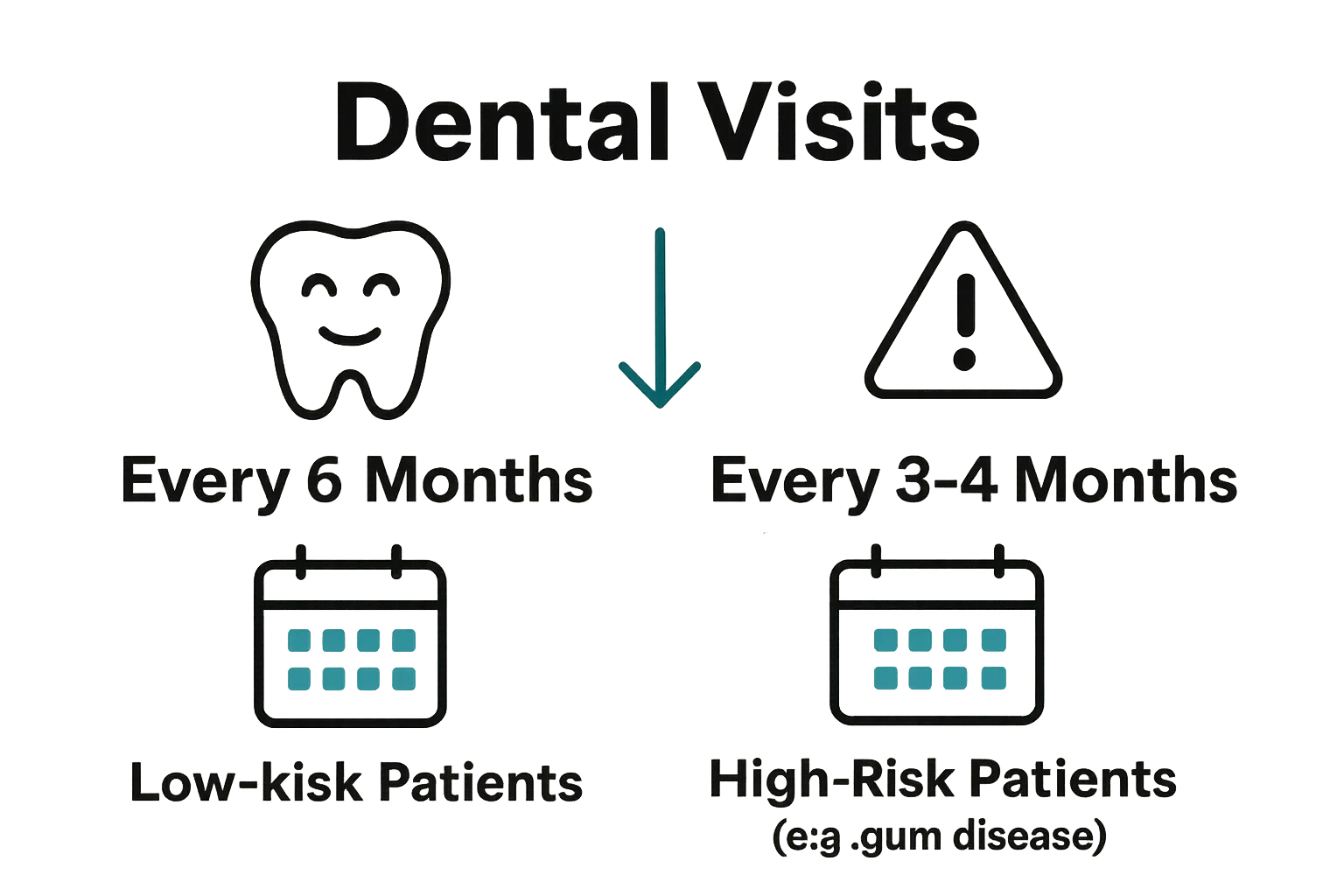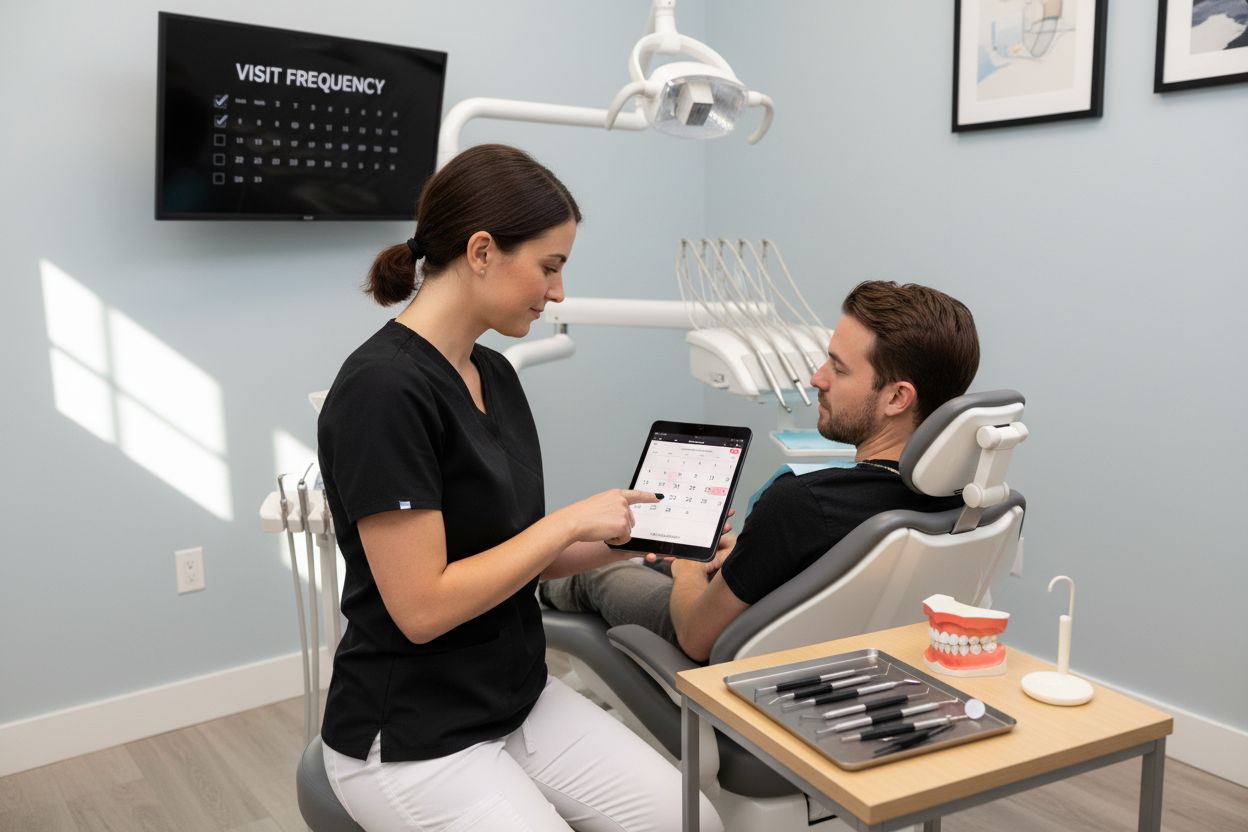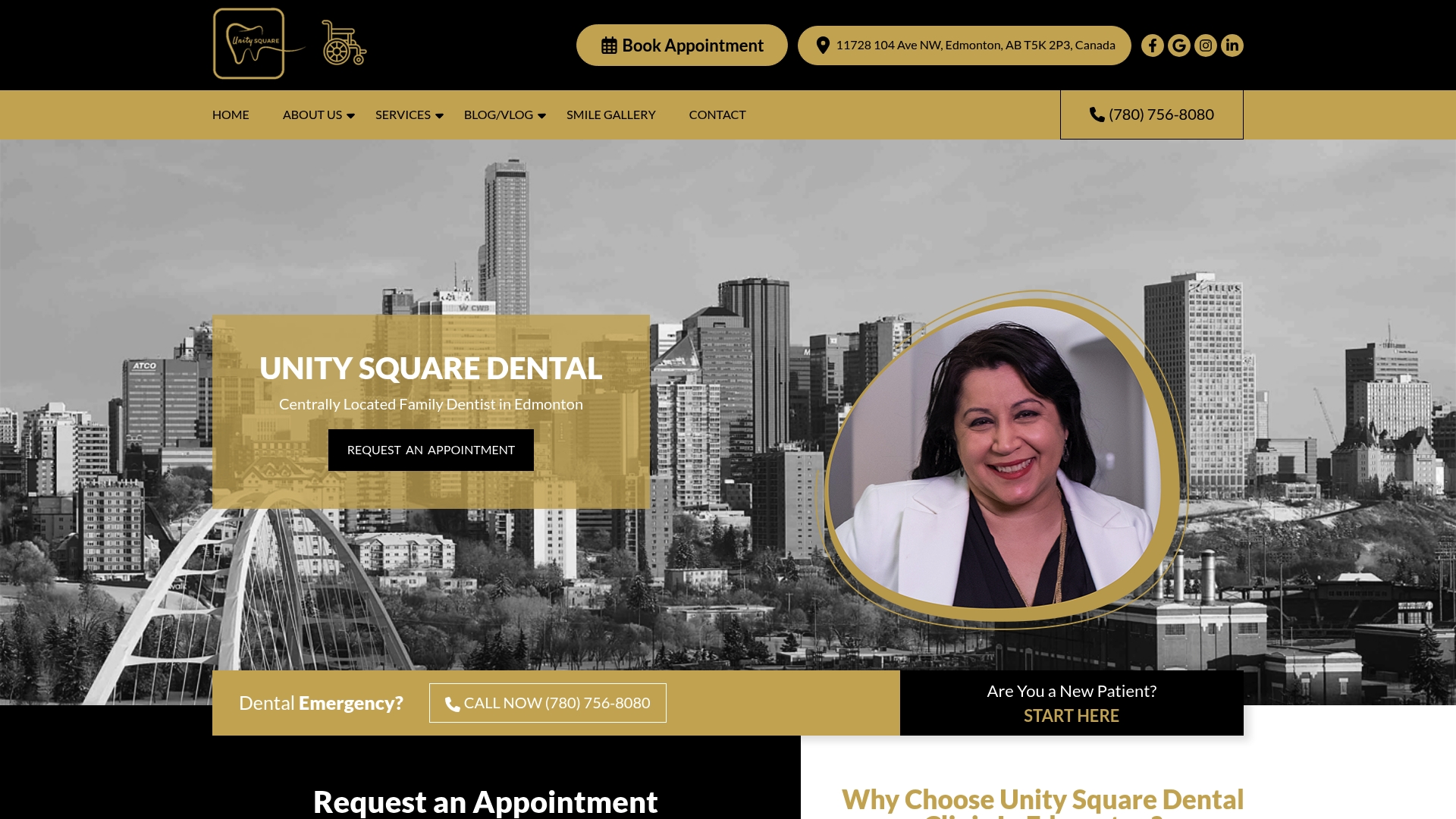
Many people wonder how often they really need to see the dentist. Dentists do not just guess the answer and actually consider a mix of unique factors before recommending a schedule. Most adults with healthy teeth only need check-ups every six months, but some people might need visits every three or four months depending on their health and habits. Surprised? That gap between appointments is not just about tooth health. It can be a sign of how your life, stress levels, medical conditions, and even genetics change the entire dental plan.
Table of Contents
- Step 1: Assess Your Dental Health Needs
- Step 2: Schedule An Initial Consultation With A Dentist
- Step 3: Follow The Dentist’s Recommended Visit Frequency
- Step 4: Adapt Visit Frequency Based On Personal Circumstances
- Step 5: Monitor Your Dental Health Between Visits
Quick Summary
| Key Point | Explanation |
|---|---|
| 1. Assess your unique dental needs | Evaluate your oral health to tailor your dental visit frequency based on your specific health factors and risk profile. |
| 2. Schedule an initial consultation | Book a dentist appointment within one to two months to establish a personalized dental care strategy and address specific oral health concerns. |
| 3. Follow dentist’s visit recommendations | Adhere to the frequency advised by your dentist to maintain optimal oral health and preempt potential complications. |
| 4. Adapt based on life changes | Adjust your dental visit schedule in response to significant health changes or life events that may impact your oral health. |
| 5. Monitor oral health between visits | Stay proactive by observing changes in your dental health and maintaining a consistent home care routine to catch issues early. |
Step 1: Assess your dental health needs
Assessing your dental health needs is the critical first step in determining how often you should visit the dentist. This foundational stage helps you understand your unique oral health requirements and develop a personalized dental care strategy that protects your long-term wellness.
Every individual’s dental health journey is unique, which means there’s no universal schedule that fits everyone. Your personal dental visit frequency depends on several key factors including age, overall health status, genetic predispositions, and existing dental conditions. For instance, someone with a history of gum disease will require more frequent check-ups compared to someone with consistently healthy teeth.
Begin by conducting a comprehensive self-evaluation of your current oral health. Consider your medical history, any existing dental issues, and lifestyle factors that might impact your oral wellness. Are you prone to cavities? Do you have diabetes or other systemic conditions that could affect your dental health? Do you smoke or consume foods and beverages that stain or damage teeth? These questions help you understand your specific risk profile.
To make this assessment more structured, our guide on essential dental health questions can provide additional insights into what factors you should consider. Documenting your observations and creating a baseline understanding of your oral health status will help you and your dental professional design the most appropriate check-up schedule.
The table below provides a quick checklist to help you assess your personal dental health needs before visiting a dentist.
| Assessment Criteria | What to Look For | Why It Matters |
|---|---|---|
| Oral hygiene practices | Frequency and quality of brushing/flossing | Informs your risk for plaque, cavities, gum issues |
| Family history | Presence of dental problems in close relatives | Indicates genetic predispositions to oral issues |
| Chronic medical conditions | Diabetes, autoimmune disorders, other health issues | Can elevate your risk for dental complications |
| Lifestyle and dietary habits | Smoking, sugar intake, staining foods/beverages | Affects decay, staining, gum health |
| Existing dental work/treatments | Fillings, crowns, ongoing or recent dental work | May need additional monitoring and care |
Key evaluation criteria should include:
- Current oral hygiene practices
- Family history of dental problems
- Presence of chronic medical conditions
- Lifestyle and dietary habits
- Any existing dental work or ongoing treatments
Consulting with a dental professional remains the most accurate way to determine your ideal visit frequency. They can perform a thorough examination, assess your unique risk factors, and recommend a personalized dental monitoring plan that adapts to your changing health needs over time.
Step 2: Schedule an initial consultation with a dentist
Scheduling your initial dental consultation transforms your oral health assessment from a theoretical concept into a concrete action plan. This step bridges the gap between understanding your dental needs and receiving professional guidance tailored specifically to your situation.
The initial consultation serves as a comprehensive diagnostic and strategic planning session. During this appointment, your dentist will conduct a thorough examination, review your medical history, and develop a personalized dental care strategy. Preparation is key to making the most of this crucial first meeting.
Start by researching local dental practices that align with your specific needs. Look for clinics offering comprehensive services, modern technology, and a patient-centered approach. Learn more about what to expect during your first dental visit to help you feel more comfortable and informed before your appointment.
When contacting the dental office, be prepared to provide detailed information about your oral health history. This includes previous dental work, current medications, existing medical conditions, and any specific concerns you want to address. Many practices offer multiple contact methods including phone, online booking, or email, so choose the method most convenient for you.
Key information to have ready when scheduling your consultation:
- Personal medical history
- List of current medications
- Dental insurance details
- Specific oral health concerns or symptoms
- Preferred appointment times
Be proactive about scheduling and aim to book your consultation within a reasonable timeframe from your initial self-assessment. Most dental professionals recommend scheduling within one to two months of identifying your dental health needs. During the consultation, engage actively by asking questions, discussing your health goals, and understanding the recommended frequency of future dental visits.
Successful completion of this step means you’ve established a professional relationship with a dentist who understands your unique oral health requirements and can provide personalized guidance for maintaining your dental wellness.
Step 3: Follow the dentist’s recommended visit frequency
Following your dentist’s recommended visit frequency is crucial for maintaining optimal oral health and preventing potential dental complications. This step transforms professional advice into a structured, actionable dental care routine that protects your long-term wellness.
Dental visit recommendations are not one-size-fits-all. Your personalized schedule depends on multiple factors including your age, overall health, existing dental conditions, and individual risk factors. Most adults with good oral health typically require dental check-ups every six months, but this can vary significantly based on your specific needs.
Establishing a consistent dental visit routine requires strategic planning and commitment. Create a system that helps you track and remember your appointments. This might involve setting calendar reminders, scheduling your next appointment immediately after each visit, or using digital tools that send automated appointment notifications. Explore our guide on dental cleaning frequency for additional insights into maintaining a regular dental care schedule.
Pay close attention to your dentist’s specific recommendations. Some individuals with complex dental histories or higher risk factors might need more frequent visits, potentially every three to four months.
 Patients with conditions like diabetes, periodontal disease, weak immune systems, or a history of rapid plaque buildup may require more intensive monitoring.
Patients with conditions like diabetes, periodontal disease, weak immune systems, or a history of rapid plaque buildup may require more intensive monitoring.
Key strategies for maintaining your recommended dental visit schedule:
- Document your dentist’s specific visit frequency recommendation
- Set multiple reminder systems (digital calendar, phone alerts)
- Discuss potential flexible scheduling options
- Understand the reasoning behind your personalized schedule
- Budget for regular dental visits in advance
Remember that following your recommended visit frequency is more than just showing up for appointments. It’s about building a proactive approach to your oral health. Each visit provides an opportunity for professional cleaning, early problem detection, and personalized guidance on maintaining your dental wellness between appointments.
Successful implementation of this step means you’ve transformed your dental care from reactive to preventative, significantly reducing the likelihood of complex and costly dental treatments in the future. Your commitment to following the recommended visit frequency demonstrates a sophisticated understanding of personal health management.

Step 4: Adapt visit frequency based on personal circumstances
Adapting your dental visit frequency to your personal circumstances is a dynamic process that requires ongoing assessment and proactive management. This step acknowledges that your oral health needs are not static but evolve with changes in your overall health, lifestyle, and medical background.
Life transitions and health changes can significantly impact your dental care requirements. Certain personal circumstances demand more frequent or specialized dental monitoring. For example, pregnancy, the onset of chronic conditions like diabetes, or significant lifestyle changes can necessitate adjusting your dental visit schedule.
Research in dental health confirms that individuals with specific risk factors may benefit from more personalized dental visit strategies. This means your dental visit frequency is not just a number, but a carefully calibrated approach to maintaining your oral wellness.
Consider major life and health transitions that might require dental care adaptation. Hormonal changes during pregnancy can increase gum sensitivity and risk of periodontal issues, potentially requiring more frequent check-ups. Similarly, individuals managing chronic conditions like diabetes or autoimmune disorders might need more comprehensive and regular dental monitoring to prevent complications.
Key indicators that might signal a need to adjust your dental visit frequency:
- Recent diagnosis of a chronic health condition
- Significant changes in medications
- Onset of pregnancy or postpartum period
- Significant stress or lifestyle changes
- Development of new oral health symptoms
Communication with your dental professional becomes crucial during these transitions. Schedule a consultation to reassess your dental care plan whenever you experience significant health changes. Your dentist can help you understand how these circumstances might impact your oral health and adjust your visit frequency accordingly.
The following table highlights circumstances that may require you to adjust your dental visit frequency and explains why communication with your dentist is important during these times.
| Situation or Change | Potential Impact on Dental Health | Action Needed |
|---|---|---|
| New chronic medical condition | Increased risk for oral complications | Schedule reassessment with dentist |
| Major medication changes | May affect gums, teeth, or oral tissue | Review dental plan with professional |
| Pregnancy or postpartum period | Higher gum sensitivity, risk of disease | Increase monitoring and check-ups |
| Significant lifestyle or stress changes | Affects immune system, oral hygiene | Inform dentist; reassess visit needs |
| New dental symptoms or issues | Early sign of dental disease | Schedule prompt dental exam |
Successful implementation of this step means developing a flexible, responsive approach to your dental care. By remaining proactive and attentive to your changing health needs, you transform dental visits from a routine procedure into a personalized health management strategy. This approach ensures that your oral health care remains precisely tailored to your unique circumstances, providing the most effective protection and prevention possible.
Step 5: Monitor your dental health between visits
Monitoring your dental health between professional visits is a critical component of maintaining optimal oral wellness. This proactive approach transforms dental care from a reactive process to a continuous, preventative strategy that empowers you to catch potential issues before they become significant problems.
Consistent self-monitoring requires developing a keen awareness of your oral health signals. Pay close attention to any changes in your mouth, such as unexpected sensitivity, unusual discoloration, persistent bad breath, or subtle shifts in how your teeth feel when biting or chewing. These seemingly minor indicators can often be early warning signs of developing dental conditions that require professional evaluation.
Learn more about maintaining optimal oral health practices to support your between-visit monitoring strategy. Establishing a robust home dental care routine is fundamental to tracking your oral health effectively. This includes maintaining rigorous daily hygiene practices like thorough brushing, proper flossing techniques, and using appropriate oral care tools tailored to your specific needs.
Create a systematic approach to tracking your oral health. Consider maintaining a simple journal or digital log where you record observations about your teeth and gums. Note any changes in sensitivity, appearance of new spots or discolorations, gum condition, or unexplained discomfort. This documentation becomes a valuable resource during your professional dental consultations, providing your dentist with a comprehensive view of your oral health progression.
Key elements to monitor between dental visits:
- Tooth sensitivity and pain
- Gum color and texture
- Appearance of new spots or changes in tooth color
- Bleeding or swelling during brushing
- Persistent bad breath
- Changes in bite or tooth alignment
Technology can be an excellent ally in dental health monitoring. Many smartphone apps and digital tools now help track oral hygiene habits, provide brushing technique guidance, and remind you of important dental care practices. Utilize these resources to maintain consistency and gain insights into your oral health patterns.
Successful implementation of this step means transforming yourself from a passive dental patient to an active participant in your oral health management. By developing a systematic, attentive approach to monitoring your dental wellness between professional visits, you create an additional layer of protection that complements your regular dental check-ups.
Ready for Personalized Dental Care in Edmonton?
Understanding how often you should visit the dentist is just the start. If you are feeling uncertain about your personal dental health risks or concerned about missing small signs of trouble, you are not alone. Many people struggle with knowing when to seek routine care or how to adapt their schedule after life changes. The article highlighted that proactive steps, such as consistent self-assessment and professional guidance, are key to protecting your smile. But navigating these stages without support can make you anxious.

Let Unity Square Dental make the process easier for you. We offer complete family dental services, cutting-edge technology, and compassionate professionals who help you take charge of your oral health. We even guide you through every step from your first consultation to routine follow-ups. Explore tips for your first visit or discover how often dental cleanings suit your family’s needs. For questions or to book your next appointment, visit Unity Square Dental today. Secure your spot now and experience truly personalized dental care in Edmonton.
Frequently Asked Questions
How often should I visit the dentist?
Most adults with good oral health typically require dental check-ups every six months. However, your visit frequency may vary based on personal factors such as age, overall health, and existing dental conditions.
What factors determine how often I need dental visits?
Your dental visit frequency is influenced by several factors including age, overall health, genetic predispositions, and existing dental issues. Individuals with a history of gum disease or chronic conditions may require more frequent visits.
How can I assess my dental health needs before visiting the dentist?
You can assess your dental health needs by conducting a self-evaluation of your oral hygiene practices, medical history, and lifestyle factors. Consider whether you are prone to cavities, have chronic health conditions, or lifestyle habits that may affect your dental health.
What should I do if my oral health changes?
If your oral health changes due to new medical conditions, medications, or lifestyle shifts, it’s essential to communicate with your dentist. Schedule a consultation to reassess your dental care plan and adjust your visit frequency as needed.
Recommended
- Dental Cleaning Frequency: Best Advice for Edmonton Families 2025 – Unity Square Dental
- Understanding How Often to Brush Teeth for Optimal Health – Unity Square Dental
- How Often to Visit Dentist in Edmonton: 2025 Family Guide – Unity Square Dental
- 7 Most Common Dental Treatments You Should Know – Unity Square Dental

